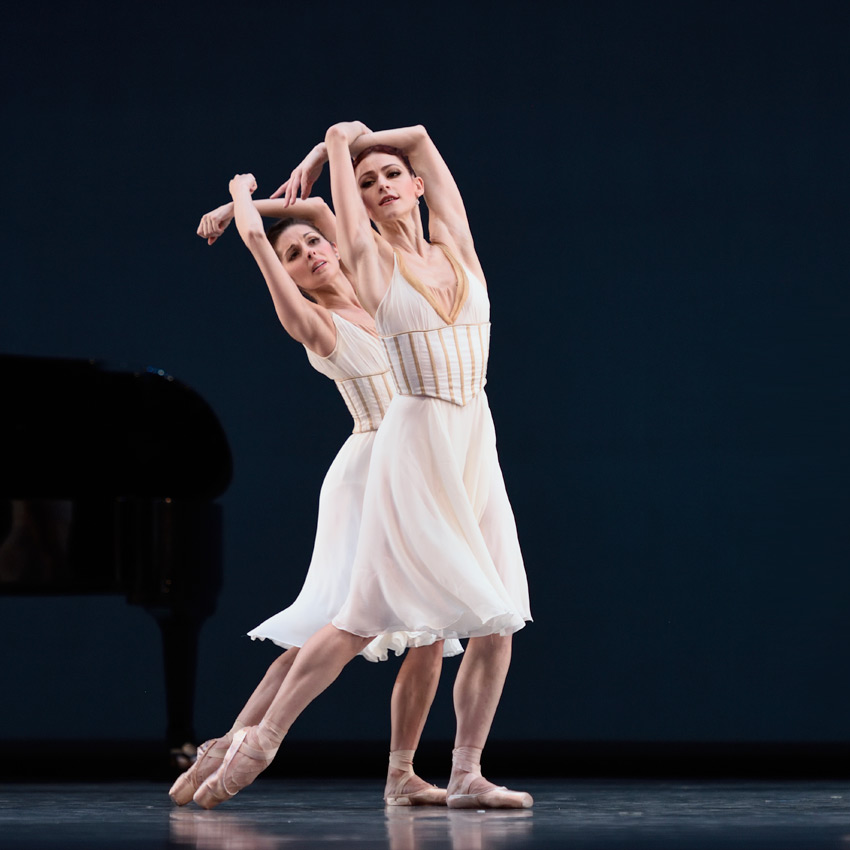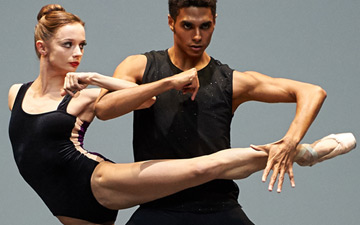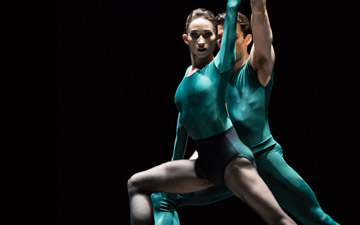
© Erik Tomasson. (Click image for larger version)
San Francisco Ballet
Program 2: Modern Masters: Seven Sonatas, Optimistic Tragedy, Pas/Parts 2016
★★✰✰✰
San Francisco, War Memorial Opera House
31 January 2017
www.sfballet.org
Helgi Tomasson usually get mixed bills just right for San Francisco Ballet; the season opened strong with Program 1’s blend of Tomasson’s neoclassicism and contemporary ballets by Jiří Bubeníček and Justin Peck. That momentum stalled in Program 2, titled Modern Masters; it debuted on Thursday 26 January, and I saw it on Tuesday 31 January.
The trouble with Program 2 is its centerpiece, choreographer-in-residence Yuri Possokhov’s new work Optimistic Tragedy. Possokhov loves high concepts and mixed media, and in Optimistic Tragedy he takes inspiration from the 1933 play by Vsevolod Vishnevsky and Sergei Eisenstein’s 1925 silent film Battleship Potemkin to tell the story of a Soviet Commissar (Lorena Feijoo) who comes aboard a battleship run by a Captain (Luke Ingham) and populated by an uneasy mix of communists and anarchists.
In text projected onto three video screens (sets by Alexander V. Nichols), Possokhov dedicated Optimistic Tragedy to “those who sacrificed their lives for future generations,” but the 35-minute work, with a dynamic original score by Ilya Demutsky, neither defines that sacrifice, beyond the broadest terms, nor provides a context for why it matters.

© Erik Tomasson. (Click image for larger version)
Dressed in a leather jacket and a skirt slit up to there, and given steps that evoke little more than sultry domination, the antagonist Commissar comes across as a sexy wrench thrown into a chaos machine of male libido. One of the men tries to rape her, and she dispatches him with a pistol. She takes up with the Captain, while projections of waves, firing squads, bombings and shipboard emergencies play out behind an ensemble of sixteen corps and soloist sailors.
Mark Zappone’s costumes enhance the all-male ensemble by draping their bodies rather than revealing them, which pushed content to the forefront; unfortunately, that also exposed the shallowness of the libretto. On the other hand, unlike Possokhov’s 2015’s Swimmer, there was too little abstraction to create a mesmerizing male ensemble that speaks for itself.
The Commissar’s death, and eventually the crew’s, has obvious personal resonance for Possokhov, who grew up in the Soviet Union and continues to process that experience through his work. In this case, the personal does not equal the political. Optimistic Tragedy could have been a searing referendum on the current political climate and a reminder of history’s very real potential to repeat itself; in the context of a plot based on more than sexual stereotypes, we could have all felt like we took a bullet to the heart.

© Erik Tomasson. (Click image for larger version)
Alexei Ratmansky’s Seven Sonatas started the evening on a hopeful note. A repeat from last season, this choreographic interpretation of Domenico Scarlatti’s Keyboard Sonatas (played onstage by Mungunchimeg Buriad) echoes Mark Morris’s Drink to Me Only with Thine Eyes and Jerome Robbins’s Dances at a Gathering in vignettes that ride a pleasant, if unmemorable, line between light drama and subtle charm.
The cast was uniformly strong – Joseph Walsh, Frances Chung, Sofiane Sylve and Carlo Di Lanno have all danced it before, and imbue the steps with lyricism and effervescence. Soloists Lauren Strongin (in a compelling central duet with Walsh, her husband) and Angelo Greco made excellent debuts.

© Erik Tomasson. (Click image for larger version)
William Forsythe’s Pas/Parts 2016 has been reviewed here twice in the past year, both times with the originating cast. Their presence was missed on Tuesday night, although to be fair, I was called away before the performance was complete. Jennifer Stahl, Lorena Feijoo, Diego Cruz and Jahna Frantziskonis (a debut for her this season), brought their own physicality to the anchorless, abstract work, set to a recorded Thom Willems sound score, but Pas/Parts loses some of its edge without the first cast’s cutting style.

















You must be logged in to post a comment.